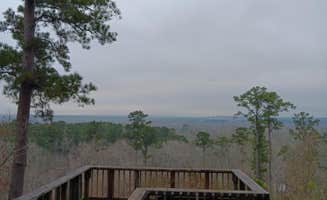Dispersed camping near Jacksonville, Texas primarily centers around the national forest lands approximately 40 miles from the city. The Davy Crockett National Forest contains several primitive camping areas with elevations ranging from 200-400 feet, creating varied terrain for outdoor enthusiasts. These camping locations typically experience hot, humid summers with temperatures regularly exceeding 90°F, while winter nights can drop below freezing during December through February.
What to do
Morning wildlife viewing: At Neches Bluff Overlook Campground, early risers are rewarded with natural encounters. "Great view in mornings and nights 10/10," reports Yasmin S. The observation deck provides excellent spotting opportunities at dawn when wildlife is most active.
Creek exploration: The forest contains numerous seasonal streams and waterways perfect for hiking and exploration. "We found a spot that had been used before, and it was very secluded and private. There was a creek nearby that we hiked up and down, even found what appeared to be a natural spring feeding the creek," shares Rachel H. about her experience at Neches Bluff Overlook Campground.
Fishing opportunities: Local waterways provide good fishing conditions, particularly for sand bass. "If you like fishing this is a popular fav spot among locals. You can float the river most either way overall. Sand bass is a fav when in season," notes a visitor about Angelina River/Hwy 59 Dispersed camping area.
What campers like
Seasonal quietude: Winter camping offers a more solitary experience in this region. "I've been to this campground a few times now during different seasons. It can get a little rowdy and also overgrown in the spring and summer, but it is perfect during a mild winter day. Come during a weekday and you'll almost surely have the whole place to yourself!" explains Raymond H. about Neches Bluff Overlook Campground.
Natural simplicity: The undeveloped nature of these sites appeals to those seeking basic camping experiences. "Love this location everything was so simple nothing extra just simple relaxing camping and beautiful scenery," shares Austin B. The minimal development maintains the natural environment.
Morning vistas: The topography creates memorable morning views for those who camp near overlook areas. "Crept up the hill in the middle of the night to wake up to a beautiful view!" reports Jadon B., highlighting the reward for those willing to set up camp in strategic locations.
What you should know
Seasonal conditions: The campgrounds change significantly with the seasons. Vegetation grows quickly in spring and summer, sometimes obscuring trails and campsites. Winter offers more open terrain and visibility, with temperatures typically ranging from 35-60°F.
Water availability: No potable water exists at most dispersed sites. Campers must either bring all water needed or have filtration systems. "We used the creek as our water supply, and the water was delicious," notes one camper, though proper filtration is always recommended regardless of water appearance.
Firewood sourcing: Local businesses offer economical firewood options that can save time compared to gathering at camp. "I would suggest getting firewood in Alto (15 minutes away) at Custom Cut Lumber. You can get pine firewood at 20 bucks a pickup load. It's self load but a really great deal," advises David P. from his stay at Neches Bluff.
Tips for camping with families
Bathroom planning: Most dispersed camping areas have minimal or no bathroom facilities. "4 Stars based on Dispersed/Free Camping w/ a clean pit toilet," mentions VanpeDiem D., noting that Sandy Beach Park has basic facilities that work for families with younger children.
Poison plant awareness: Teach children to identify common irritant plants before arrival. "There is some spots of poison Oak/Ivy to be aware of, but nothing unavoidable and was in one area," notes Rachel H., indicating the importance of showing children what to avoid.
Water caching: For longer stays, consider placing water supplies at strategic locations before setting up camp. "We bikes from the Ratcliff Recreational Area and we had to cache water," shares Adam H., highlighting the planning needed for extended stays, especially with children.
Tips from RVers
Road conditions: Forest service roads vary significantly in quality based on recent weather. "The forest service road to get to the campground is pretty level and appears you could get an rv or pull behind through it. Plenty of turn around space at multiple sites," reports David P., suggesting larger vehicles can access certain areas during dry conditions.
Site selection timing: Arrive during daylight to properly assess site options, especially for larger vehicles. "I'd suggest getting here with some daylight to find a site if coming on a weekend," advises a regular visitor, noting weekend congestion can make finding appropriate RV sites challenging.
Site arrangement: The campground has multiple areas suitable for different types of camping setups. Some areas can accommodate larger rigs while others are better for tent camping only, with approximately 5-8 informal sites spread across three distinct camping areas.


